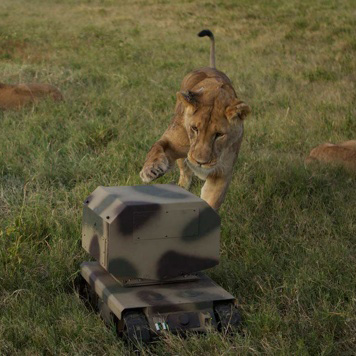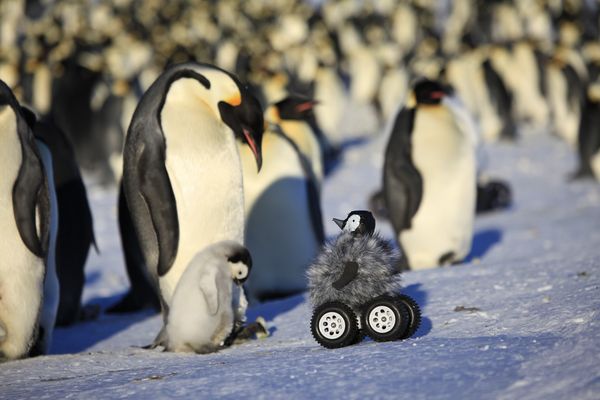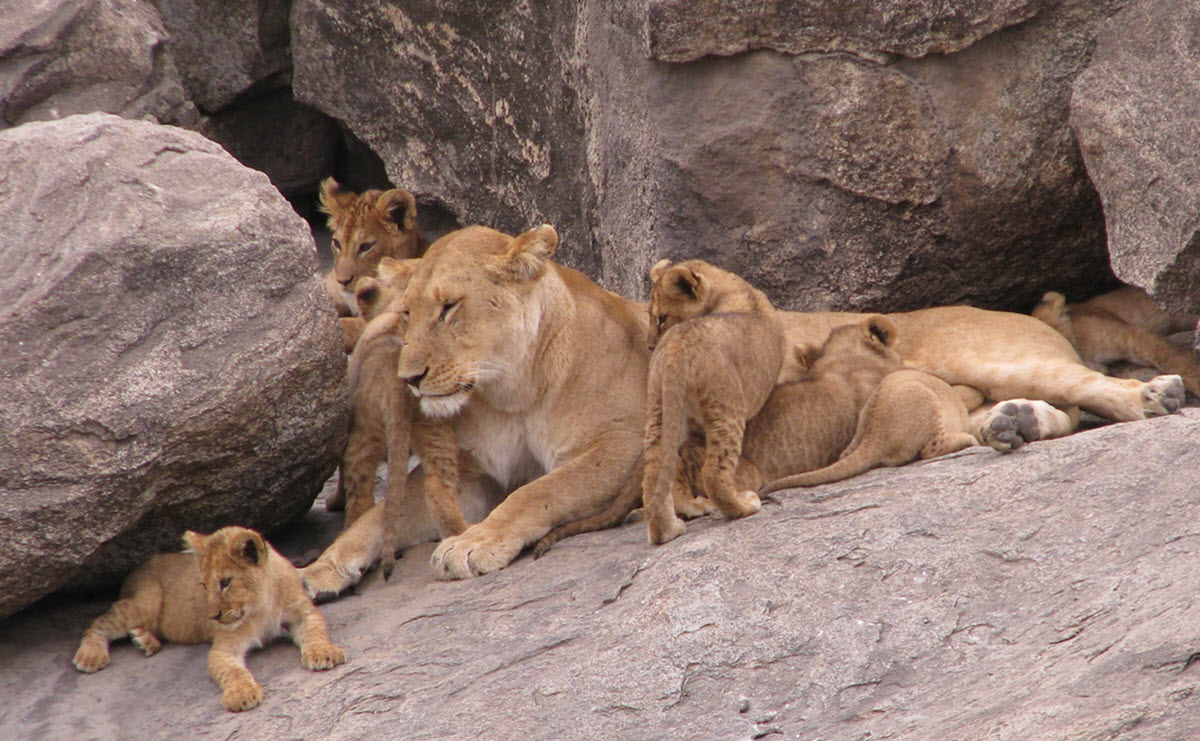- Robots are providing unprecedented access to study lives, habits and habitats of animals – some in remote and unfamiliar terrain.
- Research on penguins showed robots cause minimal disturbance in colonies.
- The technology is in its infancy but holds potential.
If a droid like Star Wars’ R2-D2 could help train the galaxy’s last known Jedi, Luke, and defeat the Empire, imagine what a SuperDroid might be capable of? Perhaps living with big cats with no more than a whisper in response?
For nearly two years, a National Geographic photographer and videographer took an in-depth look at the lives of lions in the unforgiving plains of the Serengeti using various gadgets, such as infrared cameras, night-vision goggles, micro-drones and a remote-controlled camera robot. This robot, known as SuperDroid, held two cameras – for stills and video – operated about 20 feet away by the photographer, Michael Nichols and videographer, Nathan Williamson.

The stunning film and accompanying article by David Quammen, the results of more than five years of planning and research, showcased the “social hierarchy and behavior” of the Vumbi pride, and it illustrated how man and lion can coexist. A senior photo editor at National Geographic told The Verge that the goal of the project was to “dispel myths about lions, to show how lions live and what it means for people to live with lions.”
Filming the lives of lions using robots wasn’t easy work: it took about two years to capture these cats on camera. According to the Superdroid Robots website, after the first year, “minor” changes were made to the camera pan and tilt system so swats and pressure by 150 kg (330 lb) lions did not affect it. The 18 kg (40-lb), 69 cm (27-in) long and 43 cm (17-in) wide bot has a battery life of one to four hours, depending on use, comes with a motor controller, and can navigate most terrains while carrying about 25 pounds of additional payload. The center cavity of the machine has enough space to mount cameras and batteries. A custom program was written “to control the robot from the safety of the truck” where images from the camera were captured and controlled remotely over a Wi-Fi network.
Here are some National Geographic’s highlights of filming with the robots — the NatGeo site explains the work through a series of stunning photos:
Bots have been there before
While this might be the first time a SuperDroid was used, it is definitely not the first time a camera mounted on a robot has been used to study animal behavior. Michelsen et al. (1992) used a mechanical model of a bee to study the waggling motion of honeybees used in communication transfer. G. L. Patricelli et al. (2006) used robotic female satin bowerbirds to study whether and how much male satin bowerbirds decreased the intensity of their display in response to having startled the female birds. Similarly, in 2010, Patricelli and Krakauer studied courtship behavior of grouse, using a grouse-bot (a robot in the skin of a female bird).
Are robots intrusive?
To study disturbance caused by robots among wild animals, Le Maho et al. (2014) from the Centre National de la Recherche Scientifique in Strasbourg, France deployed a remote-controlled rover disguised as a penguin chick. The team studied the behavior and heart rates of 34 incubating king penguins (Aptenodytes patagonicus) when these birds were approached by humans or a rover. They found that the penguins’ heart rate was “significantly lower” when approached by a rover rather than a human. In addition, the team tested the effect of rovers on 158 emperor penguins (Aptenodytes forsteri) and found that 44 of them “reacted with alertness”; 75 showed no reaction, and 39 were curious about the device and came closer to inspect further. Interestingly enough, when the rover was disguised as a penguin chick, adult as well as chick emperor penguins did not just come close but were heard vocalizing at the bot.
By excluding humans from the immediate environment, remote photography has allowed scientists to successfully document behavior of not just lions but also other potentially dangerous species. Le Maho et al. (2014) conducted a pilot study on tagged elephant seals dozing near the penguins, who seemed unperturbed by the whizzing contraption. “This is notable, as elephant seals generally react strongly when humans approach their tails,” the paper stated.

Cutler and Swann (1999) have shown that remote photography in general is “less invasive” and especially useful for studying animals in dens, cavities, and difficult-to-access terrain. The hard data gathered through remote photography cannot be disputed. Most importantly, smell and presence of humans can disrupt animal behavior, a problem that is nearly eliminated when using robots and/or remote cameras.
Although the animals are curious about the “new member,” after a few cautious days of pecks (as in case of penguins), swats, sniffs and growls (as in case of lions) that elicit no response from the machine, the new entrant is ignored. Once the animals are accustomed to the device, the biological study can begin.
Challenges with droid use
Droid use, especially with custom-built units, has its share of problems. A National Geographic interactive teaser of the film shows videographer Nathan Williamson tinkering with the device and wistfully acknowledging that these robots require “a ton of attention”. In addition the Nat Geo team had to contend with what seemed to filmmaker Michael Nichols like “constant” Wi-Fi failure.
The penguin researchers also needed to tweak their system after their initial deployment. According to their paper, in the first season (2009-2010), they deployed a 40 cm x 40 cm x 40 cm rover weighing 40 kg (88 lbs). But the large cube was difficult to maneuver, so the next season (2010-2011), they used a rover that was just a tenth of the size and, weighing just 1.3 kg (3 lbs), a fraction of the weight. While they could operate the device from about 200 meters away, penguins repeatedly obstructed the view, so they had to operate it from just 30-40 meters away. Further improving on this technology for the 2013-2014 season, the team returned to a larger a 30 cm x 30 cm x 30 cm device, which featured a 0.24 m2 field of detection, as opposed to the 0.06 m2 field in earlier versions. This made for faster identifications of penguins while the rover moved among them.

Just as with cameras for penguins, when technological wrinkles were smoothed out, the National Geographic team got some never-before-seen eye-level terrestrial photographs of lions, quite distinct from traditional photographs that “looked down” on lions through a telescopic lens. The SuperDroid takes us into the lives of C-Boy, Hildur, and the rest of the pride. The cameras get close enough to see their scars, count their teeth, and make one take a few steps back as the cats tear into their food. Such up-close and personal footage of lions’ behavior and use of various resources and habitats could help us understand what it would take to make sure this species prospers.
While they can go where no humans have gone before, robots used in wildlife research are still custom-built, and maintaining and programming them is no easy task. However, as robotics and electronics shrink in size and price and improve in quality, their use in recording not just imagery but environmental conditions or animal movement patterns, may enhance traditional ecological research methods.
Have you used robotics for your work? If so, how was the experience?
Citations
Cutler, T. L. and Swann, D. E. (1999) Using remote photography in wildlife ecology: A review. Wildlife Society Bulletin (1973-2006) Vol. 27, No. 3, pp. 571-581.
Le Maho, Y., Whittington, J. D., hanuise, N., Pereira, L., Boureau, M., Brucker, M., Chatelain, N., Courtecuisse, J., Crenner, F., Friess, B., Grosbellet, E., Kernaleguen. L., Olivier, F., Saraux, C., Vetter, N., Viblanc, V. A., Thierry, B., Tremblay, P., Groscolas, R. and Bohec, C. Le (2014) Rovers minimize human disturbance in research on wild animals. Nature Methods 11, 1242-1244.
Michelsen, A., Andersen, B. B., Storm, J., Kirchner, W. H. and Lindauer, M. (1992) How honeybees perceive communication dances, studied by means of a mechanical model. Behav. Ecol.Sociobiol. 30, 143–150
Patricelli G.L., Coleman S.W. and Borgia G. (2006) Male satin bowerbirds, Ptilonorhynhcus violaceus, adjust their display intensity in response to female startling: an experiment with robotic females. Anim Behav 71:49–59.
Patricelli, G.L. and Krakauer, A. H. (2010) Tactical allocation of display effort reduces trade-offs among multiple sexual signals in greater sage-grouse: an experiment with a robotic female. Behavioral Ecology 21: 97-106.

